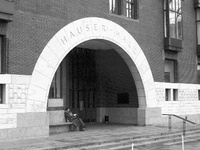“She was the mother of eight, taught boys and rusticated Harvard students in her home [and] would read Homer or Virgil as she shelled peas and rocked a cradle,” Knowles said of Ripley in a memo she sent to Emilie Norris, who is the project manager for the University cultural property survey.
Such women, many argue, deserve more recognition. But because the University’s portrait collection is composed solely of gifts, the only way to increase the number of monuments to women on Harvard’s campus is for people to commission such works, according to Grindlay.
“The process of commissioning new portraits doesn’t happen overnight,” Grindlay says.
But increasing the visibility of monuments to women is important nonetheless, says Georgene Herschbach, as their presence helps to set a tone of respect for the contributions that women have made to Harvard over the course of its history.
“It gives the message that this place is by and for women as well as men,” she says. “Women are a part of this community at every level.”
BUILDING A BRIDGE
Just as portraits of men dominate the walls here, Harvard’s buildings most often bare the names of prominent male donors and historical figures. But in the past few years, women have entered the realm of philanthropy at Harvard.
A recently built student common area beneath Memorial Hall and a renovated reading room in Widener Library were funded by donations from Katherine B. Loker, and the dorm once known as North House has taken on the name of Carol K. Pforzheimer ’31.
And some say a concerted effort from the University’s fundraisers to court women and their pocketbooks has resulted in a dramatic change.
Rita E. Hauser, a co-chair of Harvard’s $1.5 billion capital campaign that concluded in 1999, spearheaded several efforts in recent years to encourage women to donate money.
Halfway through the campaign, she says, she “discovered that women were not fully on the radar screen as a body of people to approach.”
To attempt to remedy this problem, Hauser—along with four other women with Harvard ties—set up the $15 million Harvard Women’s Matching Fund in 1998 to encourage higher levels of giving, starting with a minimum gift of $25,000 or more. Donations made by a woman were matched up to $250,000. Within 60 business days, the fund was exhausted.
Diana L. Nelson ’84, chair of the Harvard College Fund and a member of the task force, points to pre-merger tensions between Harvard and Radcliffe as a major obstacle to female giving at the time. “People who are generous to the College often can meet the College leaders and have a voice,” she says. “And I felt that women, because they were essentially being pulled in two directions, didn’t have the same kind of voice.”
Though she describes the campaign as a crucial “turning point,” she stresses that Harvard’s fundraisers must remain vigilant.
“I think we need to continue to make sure to bring women into the process and events, because I think women often have very complicated lives,” she says. “It takes some real effort to engage them. We can’t just think there’s momentum that will just draw women in without a concerted effort.”
—Catherine E. Shoichet contributed to the reporting of this story.
—Portions of this article appeared in the February 27, 2002 edition of The Crimson.









